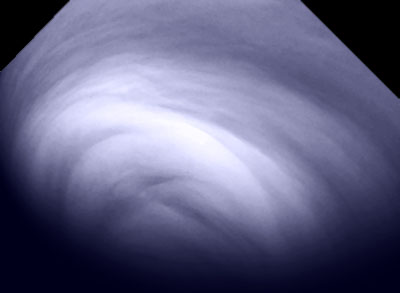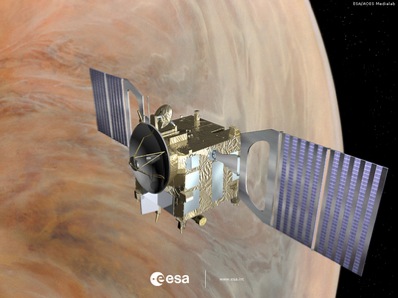
Venus Express carries warning for Earth engineers
by Lizzie Campbell
for ASTRONOMY NOW
Posted: 03 December 2010


ESA's Venus Express satellite has reported an unexpected, high altitude layer of sulphur dioxide in the planet's upper atmosphere that could act as a warning against plans to mitigate climate change on our own planet by injecting the Earth's atmosphere with sulphur droplets.

Venus' surface is covered by thick clouds. Image: ESA.
Sulphur dioxide combines with water vapour to make sulphuric acid droplets that hang in the planet’s atmosphere. These sulphuric acid clouds surrounding the “morning star” are the reason Venus is such a cryptic planet to study, as the surface is completely hidden from view.
Scientists predicted that these clouds, which form at around 50-70 kilometres above the surface, would be destroyed by solar radiation at higher altitudes. Surprisingly, Venus Express has now detected a layer of sulphur dioxide at 90-110 kilometres. Computer simulations from Xi Zhang of the California Institute of Technology and colleagues show how this anomaly could have arisen. At high altitudes, the heat from the Sun could cause some sulphuric acid droplets to evaporate into an acidic gas, which is broken apart by sunlight to form sulphur dioxide.

Artist's impression of Venus Express in orbit. Image: ESA.
This tells us more about the cryptic planet, and also has indicated some problems for advocates of environmental engineering. A plan lauded by Nobel Prize winner Paul Crutzen involves injecting large quantities of sulphur dioxide high into the Earth’s atmosphere, in an attempt to offset the effects of global warming. Similar to the effects of massive volcanic eruptions such as Mount Pinatubo, the gas sent forth from the eruption would reach around 20 kilometre altitude and form droplets of sulphuric acid at this height; creating a layer of haze that would reflect the Suns rays away from Earth, lowering the temperature by about half a degree Celsius.
But the evaporation on Venus hints that this plan may not be as effective as predicted, because we don’t know how quickly the droplets will evaporate, forming transparent gases that give us no protection against the Sun's heat. Close study will continue on this phenomenon, as we may learn much more from this natural experiment before investigating the effects closer to home. As Jean-Loup Berteaux from the Universite de Versailles-Saint-Quentin says “We must study in great detail the potential consequences of an artificial sulphur layer in the atmosphere of Earth. Venus has an enormous layer of such droplets, so anything that we learn about those clouds is likely to be relevant to any geo-engineering of our own planet.”
|



